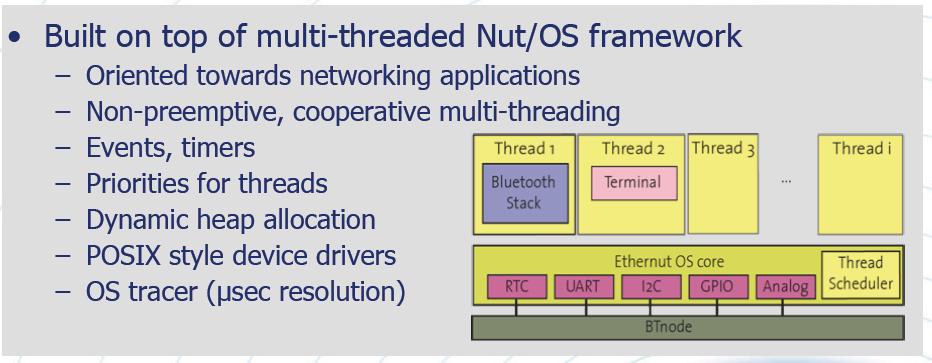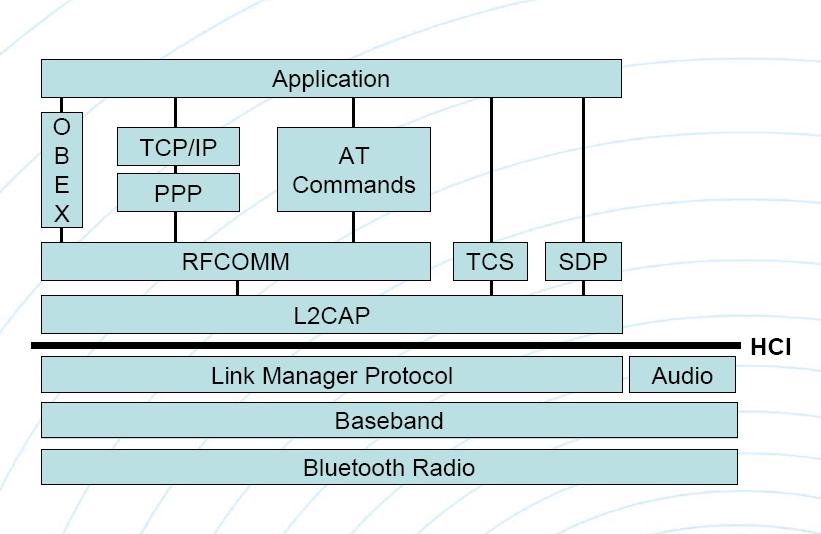WSN(Wireless sensor network) 노드(센서모듈을 가진 모듈)를 OS는 일반적인 목적의 OS보다는 덜 복잡하다. 왜냐면 단지 센서네트워크 어플리케이션 목적과 하드웨어 플랫폼도 제한적이기 때문이다.
TinyOS, Contiki, MANTIS, BTnut, SOS, Nano-RK 등이 있는데 TinyOS는 너무 잘 알려져 있고 인터넷에 관련 글도 많이 찾을 수가 있어서 TinyOS를 제외한 다른 센서네트워크용 OS를 서치해보았다.
Contiki(http://www.sics.se/contiki/)
Contiki is designed for embedded systems with small amounts of memory. A typical Contiki configuration is 2 kilobytes of RAM and 40 kilobytes of ROM. Contiki consists of an event-driven kernel on top of which application programs are dynamically loaded and unloaded at runtime. Contiki processes use light-weight protothreads that provide a linear, thread-like programming style on top of the event-driven kernel. Contiki also supports per-process optional preemptive multi-threading, interprocess communication using message passing through events, as well as an optional GUI subsystem with either direct graphic support for locally connected terminals or networked virtual display with VNC or over Telnet.
MANTIS(http://mantis.cs.colorado.edu/index.php/tiki-index.php)
The MANTIS Group at CU Boulder has developed an open source, multi-threaded operating system written in C for wireless sensor networking platforms. Some key features of MANTIS OS (MOS):
- Developer friendly C API with Linux and Windows development environments
- Automatic preemptive time slicing for fast prototyping
- Diverse platform support including MICA2, MICAz, and TELOS motes
- Energy-efficient scheduler for duty-cycle sleeping of sensor node
- Small footprint (less than 500B RAM, 14KB flash)
- BSD License

BTnut(http://www.btnode.ethz.ch/)
The Nut/OS Core, The Bluetooth Subsystem, Bluetooth L2CAP
Bluetooth Remote Procedure Calls, The Chipcon CC1000 Interface
BTnut Terminal Interface, Sensor Drivers, Power Drivers


SOS(https://projects.nesl.ucla.edu/public/sos-2x/doc/)

Nano-RK(http://www.nanork.org/nano-RK)
Nano-RK is a reservation-based real-time operating system (RTOS) from Carnegie Mellon University with multi-hop networking support for use in wireless sensor networks. Nano-RK currently runs on the FireFly Sensor Networking Platform as well as the MicaZ motes. It includes a light-weight embedded resource kernel (RK) with rich functionality and timing support using less than 2KB of RAM and 16KB of ROM. Nano-RK supports fixed-priority preemptive multitasking for ensuring that task deadlines are met, along with support for CPU, network, as well as, sensor and actuator reservations. Tasks can specify their resource demands and the operating system provides timely, guaranteed and controlled access to CPU cycles and network packets. Together these resources form virtual energy reservations that allows the OS to enforce system and task level energy budgets.

'예전글 목록' 카테고리의 다른 글
| uC/OS 분석 (0) | 2007.08.15 |
|---|---|
| 초간단 링버퍼 작성 (1) | 2007.08.14 |
| 노트북 LCD 수리 (0) | 2007.08.07 |
| 6lowpan WG (0) | 2007.08.06 |
| op-wipv6 (0) | 2007.08.05 |